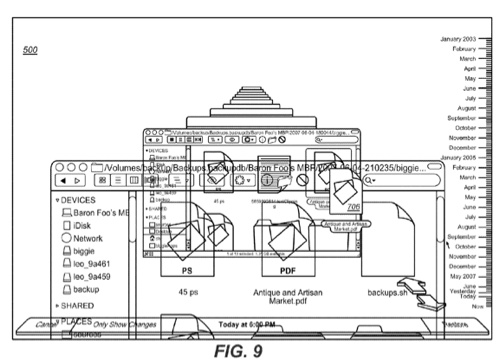An Apple patent (number 20110302502) for an user interface for electronic backup has appeared at the US Patent & Trademark Office. Systems and methods are provided for storing and restoring digital data. The patent involves current, and probably future versions, of the Time Machine features of Mac OS X.
A method includes receiving, a first user input requesting that a backup interface be displayed, displaying the backup interface, the backup interface including a display area for presenting at least a first visual representation of an earlier version of a current view and a visual representation of the current view, the earlier version including a first element, receiving, while the backup interface is displayed, a second user input requesting that the current view be modified according to the earlier version, at least with regard to the first element, animating the modification of the first element as moving from the visual representation of the earlier version to the visual representation of the current view, and modifying, in response to the second user input, the current view according to the earlier version, at least with regard to the first element. The inventors are David Hart, Mike Matas, Pavel Cisler and Kevin Tiene.
Here’s Apple’s background and summary of the invention: “Modern graphical user interfaces allow a large number of graphical objects or items to be displayed on a display screen at the same time. Operating systems, such as Apple Mac OS, provide user interfaces in which a number of windows can be displayed, overlapped, resized, moved, configured, and reformatted according to the needs of a user or a particular application. Taskbars, menus, virtual buttons and other user interface elements provide mechanisms for accessing and activating windows even when they are hidden behind other windows.
“With the sophisticated tools available, users are encouraged not only to create and save a multitude of items in their computers, but also to revise or otherwise improve on them over time. For example, a user can work with a certain file and thereafter save its current version on a storage device. The next day, however, the user could have had second thoughts about the revisions, or could have come up with new ideas, and therefore opens the file again.
“The revision process is usually straightforward if the user wants to add more material to the file or make changes to what is there. However, it is typically more difficult for a user to revert a file back to an earlier state if the user has changed his/her mind about modifications that were previously made. Application programs for word processing typically let the user ‘undo’ previous edits of a text, at least up to a predefined number of past revisions.
“The undo feature also usually is configured so that the previously made revisions must be undone in reverse chronological order; that is, the user must first undo the most recently made edit, then the second-most recent one, and so on. If the user saves and closes the document and thereafter opens it again, it may not be possible to undo automatically any previous edits.
“Systems and methods are provided for storing and restoring digital data. In general, in one aspect, a method is provided. The method includes receiving, while a current view is displayed in a user interface, a first user input requesting that a backup interface be displayed, displaying the backup interface, the backup interface including a display area for presenting at least a first visual representation of an earlier version of the current view and a visual representation of the current view, the earlier version including a first element, receiving, while the backup interface is displayed, a second user input requesting that the current view be modified according to the earlier version, at least with regard to the first element, animating the modification of the first element as moving from the visual representation of the earlier version to the visual representation of the current view, and modifying, in response to the second user input, the current view according to the earlier version, at least with regard to the first element. Other embodiments of this aspect include corresponding systems, apparatus, computer program products, and computer readable media.
“Implementations of the aspect can include one or more of the following features. Animating the modification can further includes lifting a copy of the first element from the visual representation of the earlier version, maintaining the position of the copy of the first element while animating the visual representations such that the visual representation of the earlier version falls away and the visual representation of the current view is presented, and adding the copy of the first element to the visual representation of the current view. The aspect can further include displaying the current view in the user interface, where the current view includes the modification of the first element.
“In general, in one aspect, a method is provided. The method includes receiving, while a current view is displayed in a user interface, a first user input requesting that a backup interface be displayed and displaying the backup interface, the backup interface including a display area for presenting at least a first visual representation of an earlier version of the current view and a visual representation of the current view, the backup interface further including a timeline, where the timeline represents a plurality of visual representations of earlier versions of the current view. Other embodiments of this aspect include corresponding systems, apparatus, computer program products, and computer readable media.
“Implementations of the aspect can include one or more of the following features. Displaying the backup interface can include displaying a timeline including a vertical column of tick marks. The timeline can be a condensed timeline that includes a plurality of condensed tick marks, where each condensed tick mark represents multiple individual tick marks. The timeline can animate in response to a user input. The animation can be based on a cursor position.
“The animation can further include determining an identified tick mark, the identified tick mark having a shortest distance from a cursor position and expanding the timeline to display individual tick marks relative to the identified tick mark. Displaying the individual tick marks can include magnifying the identified tick mark. A date can be displayed corresponding to the earlier version of the current view represented by the identified tick mark.
“The aspect can further include determining that the cursor position has moved, determining a next identified tick mark relative to the cursor position, and magnifying the next identified tick mark. The aspect can further include receiving an input selecting the identified tick mark, displaying the visual representation of an earlier version of the current view corresponding to the identified tick mark, and compressing the timeline to the condensed timeline.
“In general, in one aspect, a method is provided. The method includes displaying a backup interface in a user interface, the backup interface including a display area for presenting a plurality of visual representations of an earlier version of the current view and a visual representation of the current view, and displaying a timeline, the timeline including a series of steps and including one or more compressed portions and an expanded portion where each step in a compressed portion is associated with one or more earlier versions of the current view, and each step in an expanded portion is associated with only a single earlier version of the current view or the current view. Other embodiments of this aspect include corresponding systems, apparatus, computer program products, and computer readable media.
“Implementations of the aspect can include one or more of the following features. Each step can have a visible representation in the timeline and includes a tick mark. A tick mark associated with a compressed portion of the time line can be larger than a tick mark associated with an expanded portion of the timeline.
“Particular embodiments of the subject matter described in this specification can be implemented to realize one or more of the following advantages. Users can focus in and identify particular snapshots from a timeline of tick marks representing one or more snapshots. A restoration animation provides users with visual cues to the restoration of an item from a history view.”
— Dennis Sellers



